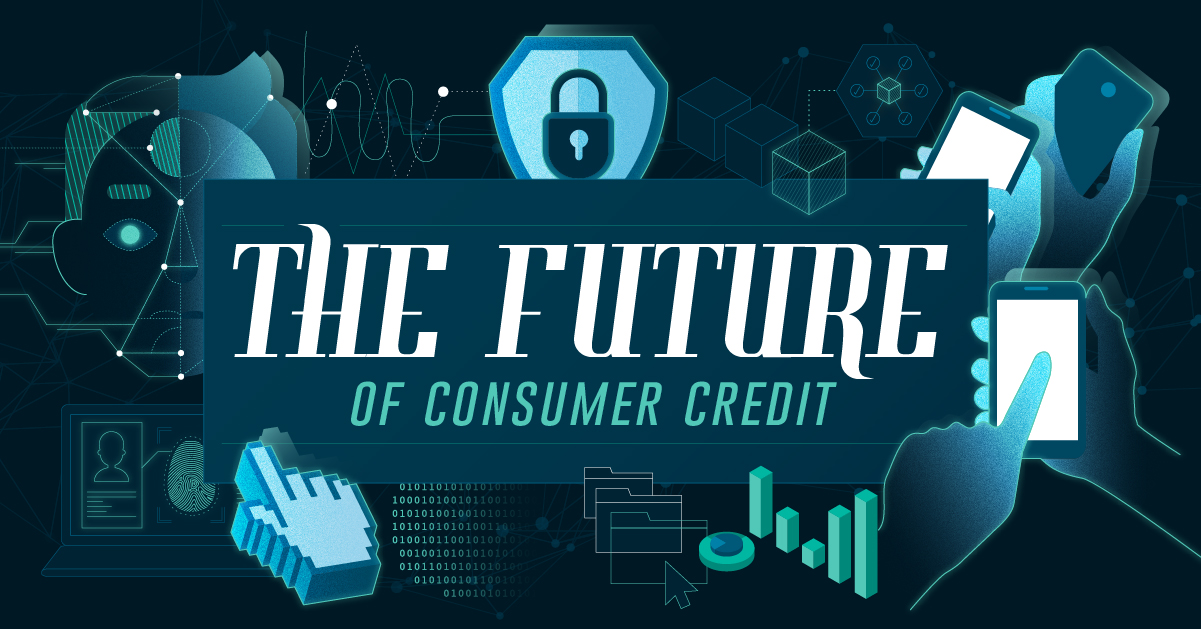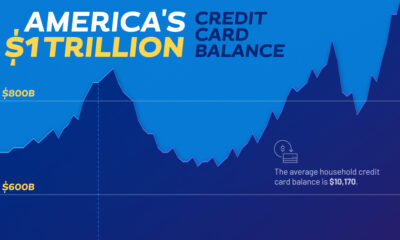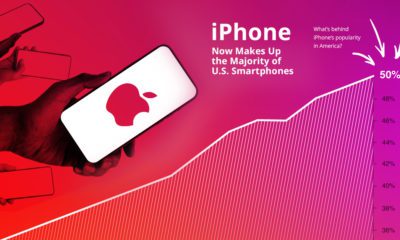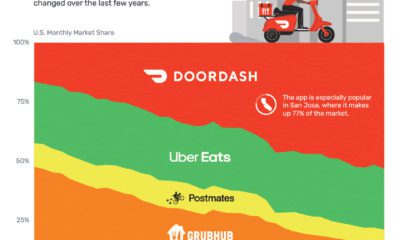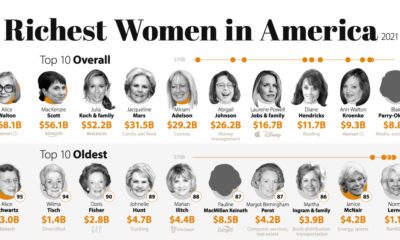Technology
How Technology is Shaping the Future of Consumer Credit
Consumer credit has been constantly evolving for more than 5,000 years, but the reality is that the most drastic changes to the industry came fairly recently.
Modern credit systems are now powered by sophisticated algorithmic credit scoring, the use of trended and alternative data, and innovative fintech applications. While these developments are all interesting in their own right, together they serve as a technological foundation for a much more profound shift in consumer credit in the coming years.
The Future of Consumer Credit
In today’s infographic from Equifax, we look at the cutting edge of consumer credit, including the new technologies and global trends that are shaping the future of how consumers around the world will access credit.
It’s the final piece of our three-part series covering the past, present, and future of credit.







The biggest problem that creditors have always faced is well-documented. There is more to a borrower than just their credit score. Yet creditors do not always have a 360 degree view of a consumer’s creditworthiness in order to better assess their overall score.
Called “information asymmetry”, this gap has gotten smaller over the years thanks to advancements in technology and business practices. However, it still persists in particular situations, like when a college student has no credit history, or when a rural farmer in India wants to take out a loan to buy seeds for crops.
But thanks to growing amounts of data – as well as the technology to make use of that data – high levels of information asymmetry may soon be a thing of the past.
Forces Shaping Credit’s Future
Here are some of the major forces that will drive the future of consumer credit, addressing the information asymmetry problem and making a wide variety of credit products available to the public:
1. Growing Data
90% of the data in all of human history has been created in just the last two years.
2. Changing Regulatory Landscape
New international regulations are putting personal data back in the hands of consumers, who can control the personal data they authorize access to.
3. Game-changing Technologies
Machine learning, deep learning, and neural networks are giving companies a way to garner insights from data.
4. Focus on Identity
Authenticating the identity of consumers will become crucial as credit becomes increasingly digital. Blockchain and biometrics could play a role.
5. The Fintech Boom
The democratization of data and tech is allowing small and niche players to come in and offer new, innovative products to consumers.
The Credit Revolution
No one can predict the future, but the above forces are shaping the credit industry to be a very different experience for consumers and businesses. Here are how things could change.
More Data, New Models
Current credit scoring algorithms use logistical regressions to compute scores, but these really max out at using 30-50 variables. In addition, these models can’t “learn” new things like AI can.
However, with new technologies and an unprecedented explosion in data taking place, it means that this noise can be converted into insights that could help increase trust in the credit marketplace. New algorithms will be multivariate, and they will be able to mine, structure, weight, and use this treasure trove of data.
| Technology | Description |
|---|---|
| Artificial intelligence | Machine learning can “learn” from massive data sets, and apply these lessons for better scoring. |
| Bayesian | Models can update probabilities as more information is available, helping to better predict creditworthiness. |
| APIs | Application programming interfaces (APIs) make it easier for developers to use technologies, data, and to build new applications. |
| Neural networks | Brain-inspired AI systems designed to replicate the way that humans learn are used for deep learning. This enables the processing of raw, unstructured, and often abstract data for new insights. |
Neural networks will be able to look at a billions of data points to find and make sense of extremely rare patterns. They will also be able to explain why a particular decision was made – and at a time where transparency is crucial, this will be key.
Data Will be in the Hands of Consumers
Today, much of consumers’ financial data – such as loan repayment histories – is held almost exclusively by banks and credit agencies.
However, tomorrow points to a very different paradigm: much of the data will be directly in the hands of consumers. In other words, consumers will be able to decide how their data gets used, and for what. In Europe, changes have already been made to transfer control of personal data to the consumer, such as the PSD2, GDPR, and Open Banking (U.K.) initiatives.
Experts see the trend towards open data growing globally, and eventually reaching the United States. Open data will allow consumers to:
- Regain control of checking, mortgage, loan, and credit card data
- Give up more information voluntarily to unlock better deals from creditors
- Grant access to third parties (fintech, apps, etc.) to use this data in new applications and products
- Gain access to better rates, new lending models, and more
Identity Will Be Just as Important
As transactions become more digital and remote, how lenders verify the identity of borrowers will be just as important as the lending data itself.
Why? Credit is based around trust – and fraud is the biggest risk for lenders.
But fraud an be prevented by new technologies that help detect anomalies and prove a borrower’s identity:
Blockchain
Distributed, tamper-resistant databases can help secure people’s identities from fraudulent activity
Biometrics
Fingerprints, facial recognition, and other biometric identification schemes could help secure identities as well
New Game, New Players
With the vast expansion in types and volume credit data, new technologies, and standardized data in the hands of consumers, there will be a new era of third-party companies and apps that can provide useful and relevant services for consumers.
Here are just some emerging fields in lending:
| Emerging fields | Description |
|---|---|
| P2P Loans | Does a bank need to be an intermediary? With peer-to-peer loans, you are matched to an appropriate lender/borrower. |
| Microlending | Lending doesn’t always need to be in big amounts, like for a mortgage or auto loan. |
| Alternative credit scoring | Psychometric testing or the use of other data streams can be used to power this less traditional form of lending. |
| Niche services | With an open playing field, companies will fill every gap imaginable. |
In the future, consumers may not have to even request credit – it may be automatically allocated to them based on behavior, age, assets, and needs.
Consumers will have more control, and more options than ever before.
Brands
How Tech Logos Have Evolved Over Time
From complete overhauls to more subtle tweaks, these tech logos have had quite a journey. Featuring: Google, Apple, and more.

How Tech Logos Have Evolved Over Time
This was originally posted on our Voronoi app. Download the app for free on iOS or Android and discover incredible data-driven charts from a variety of trusted sources.
One would be hard-pressed to find a company that has never changed its logo. Granted, some brands—like Rolex, IBM, and Coca-Cola—tend to just have more minimalistic updates. But other companies undergo an entire identity change, thus necessitating a full overhaul.
In this graphic, we visualized the evolution of prominent tech companies’ logos over time. All of these brands ranked highly in a Q1 2024 YouGov study of America’s most famous tech brands. The logo changes are sourced from 1000logos.net.
How Many Times Has Google Changed Its Logo?
Google and Facebook share a 98% fame rating according to YouGov. But while Facebook’s rise was captured in The Social Network (2010), Google’s history tends to be a little less lionized in popular culture.
For example, Google was initially called “Backrub” because it analyzed “back links” to understand how important a website was. Since its founding, Google has undergone eight logo changes, finally settling on its current one in 2015.
| Company | Number of Logo Changes |
|---|---|
| 8 | |
| HP | 8 |
| Amazon | 6 |
| Microsoft | 6 |
| Samsung | 6 |
| Apple | 5* |
Note: *Includes color changes. Source: 1000Logos.net
Another fun origin story is Microsoft, which started off as Traf-O-Data, a traffic counter reading company that generated reports for traffic engineers. By 1975, the company was renamed. But it wasn’t until 2012 that Microsoft put the iconic Windows logo—still the most popular desktop operating system—alongside its name.
And then there’s Samsung, which started as a grocery trading store in 1938. Its pivot to electronics started in the 1970s with black and white television sets. For 55 years, the company kept some form of stars from its first logo, until 1993, when the iconic encircled blue Samsung logo debuted.
Finally, Apple’s first logo in 1976 featured Isaac Newton reading under a tree—moments before an apple fell on his head. Two years later, the iconic bitten apple logo would be designed at Steve Jobs’ behest, and it would take another two decades for it to go monochrome.
-

 Money2 weeks ago
Money2 weeks agoWhich States Have the Highest Minimum Wage in America?
-

 Misc1 week ago
Misc1 week agoAirline Incidents: How Do Boeing and Airbus Compare?
-

 Environment1 week ago
Environment1 week agoTop Countries By Forest Growth Since 2001
-

 United States2 weeks ago
United States2 weeks agoWhere U.S. Inflation Hit the Hardest in March 2024
-

 Demographics2 weeks ago
Demographics2 weeks agoThe Smallest Gender Wage Gaps in OECD Countries
-

 Markets2 weeks ago
Markets2 weeks agoThe Top 10 States by Real GDP Growth in 2023
-

 Countries2 weeks ago
Countries2 weeks agoPopulation Projections: The World’s 6 Largest Countries in 2075
-

 Travel2 weeks ago
Travel2 weeks agoRanked: The World’s Top Flight Routes, by Revenue

